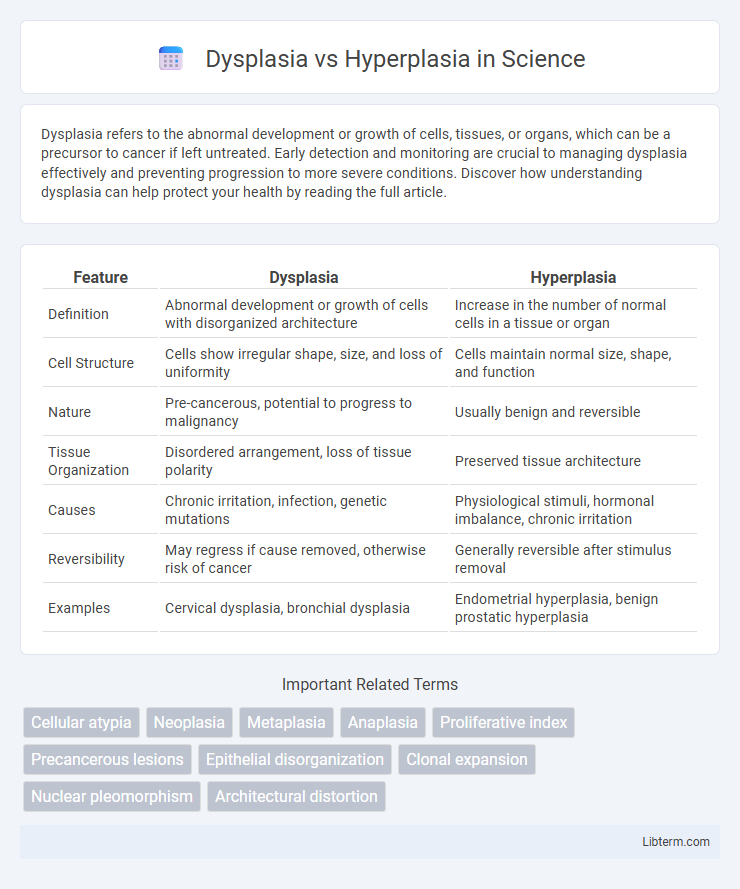Dysplasia refers to the abnormal development or growth of cells, tissues, or organs, which can be a precursor to cancer if left untreated. Early detection and monitoring are crucial to managing dysplasia effectively and preventing progression to more severe conditions. Discover how understanding dysplasia can help protect your health by reading the full article.
Table of Comparison
| Feature | Dysplasia | Hyperplasia |
|---|---|---|
| Definition | Abnormal development or growth of cells with disorganized architecture | Increase in the number of normal cells in a tissue or organ |
| Cell Structure | Cells show irregular shape, size, and loss of uniformity | Cells maintain normal size, shape, and function |
| Nature | Pre-cancerous, potential to progress to malignancy | Usually benign and reversible |
| Tissue Organization | Disordered arrangement, loss of tissue polarity | Preserved tissue architecture |
| Causes | Chronic irritation, infection, genetic mutations | Physiological stimuli, hormonal imbalance, chronic irritation |
| Reversibility | May regress if cause removed, otherwise risk of cancer | Generally reversible after stimulus removal |
| Examples | Cervical dysplasia, bronchial dysplasia | Endometrial hyperplasia, benign prostatic hyperplasia |
Introduction to Dysplasia and Hyperplasia
Dysplasia and hyperplasia are cellular responses to abnormal stimuli characterized by distinct pathological features; hyperplasia involves an increase in the number of cells within a tissue, often as a physiological or pathological adaptation, while dysplasia represents disorganized cellular growth with morphological abnormalities indicating potential precancerous changes. Hyperplasia maintains normal cellular architecture despite increased cell proliferation, whereas dysplasia disrupts tissue organization and may precede neoplastic transformation. Understanding these conditions is crucial in histopathology for early detection and differentiation of benign reactive processes from premalignant lesions.
Defining Dysplasia
Dysplasia refers to the abnormal development or growth of cells, tissues, or organs, often characterized by changes in cell size, shape, and organization, which can be precancerous. It differs from hyperplasia, which is simply an increase in the number of normal cells within a tissue or organ, resulting in its enlargement without atypical cellular changes. Recognizing dysplasia is crucial for early detection and prevention of malignant transformation in epithelial tissues.
Defining Hyperplasia
Hyperplasia is defined as the increased proliferation of normal cells within a tissue or organ, leading to its enlargement without altering cellular architecture. It differs from dysplasia, which involves abnormal cell growth and disordered tissue organization that may precede malignancy. Hyperplasia often occurs as a physiological response to stimuli such as hormonal signals or compensatory mechanisms after tissue injury.
Key Differences Between Dysplasia and Hyperplasia
Dysplasia involves abnormal cell growth with structural and functional abnormalities, often considered a precancerous condition, while hyperplasia is an increase in the number of normal cells without atypia. Dysplasia features disorganized tissue architecture and cellular atypia, whereas hyperplasia maintains normal cell appearance and orderly tissue organization. Dysplasia commonly indicates a potential progression to malignancy, whereas hyperplasia is typically a non-neoplastic, reversible process.
Causes of Dysplasia
Dysplasia is primarily caused by chronic irritation, persistent inflammation, viral infections such as human papillomavirus (HPV), and exposure to carcinogens like tobacco smoke or ultraviolet radiation. These factors induce abnormal cellular growth and differentiation, leading to disorganized tissue architecture. Unlike hyperplasia, which involves a controlled increase in cell number, dysplasia reflects a precancerous condition with potential for malignant transformation.
Causes of Hyperplasia
Hyperplasia results from an increased rate of cellular proliferation in response to stimuli such as chronic irritation, hormonal imbalance, or tissue injury, distinguishing it from dysplasia, which involves abnormal cellular morphology and disordered growth. Common causes of hyperplasia include hormonal factors like excessive estrogen in endometrial hyperplasia, compensatory mechanisms following tissue loss, and persistent inflammatory signals. Unlike dysplasia, hyperplasia is typically a reversible process that restores tissue function without immediate malignant transformation risk.
Clinical Implications and Risks
Dysplasia represents abnormal cellular growth with a high risk of progression to malignancy, requiring close clinical monitoring and possible intervention to prevent cancer development. Hyperplasia involves an increase in the number of normal cells, often reversible and less likely to evolve into cancer, but it may indicate an underlying stimulus or pathology needing treatment. Clinicians assess these conditions using biopsy and histopathology to guide prognosis and therapeutic strategies.
Diagnostic Methods
Diagnostic methods for dysplasia primarily involve histopathological examination through biopsy, where tissue samples are analyzed microscopically to detect abnormal cellular architecture and atypia. Hyperplasia diagnosis often relies on imaging techniques such as ultrasound or mammography to identify increased cell proliferation, supplemented by biopsy when tissue characterization is necessary. Immunohistochemistry and molecular markers enhance differentiation accuracy between dysplasia and hyperplasia by revealing specific protein expressions associated with cellular abnormalities.
Treatment Approaches
Treatment approaches for dysplasia typically involve removal of the abnormal tissue through surgical excision, laser therapy, or cryotherapy to prevent progression to cancer. Hyperplasia treatment focuses on addressing the underlying cause, such as hormone therapy for endometrial hyperplasia or anti-inflammatory drugs for reactive hyperplasia. Monitoring through regular follow-ups and biopsies is essential in both conditions to evaluate treatment efficacy and detect any malignant transformation early.
Prevention and Prognosis
Dysplasia prevention involves minimizing exposure to carcinogens, maintaining regular screenings, and managing chronic inflammatory conditions to halt abnormal cellular changes. Hyperplasia prevention focuses on controlling underlying causes, such as hormonal imbalances or inflammatory triggers, to prevent excessive cell proliferation. Prognosis for dysplasia varies with severity, as high-grade dysplasia carries a higher risk of progressing to cancer, while hyperplasia often has a favorable outcome if the cause is effectively addressed.
Dysplasia Infographic

 libterm.com
libterm.com